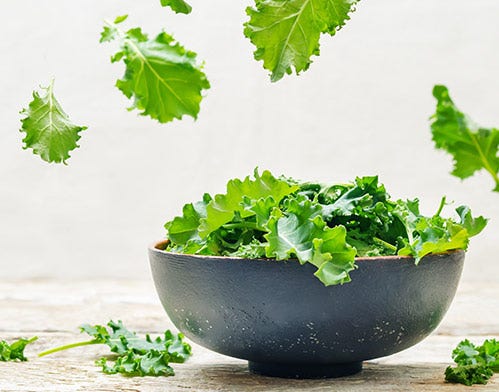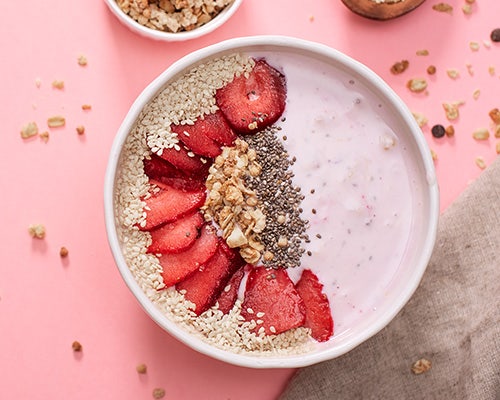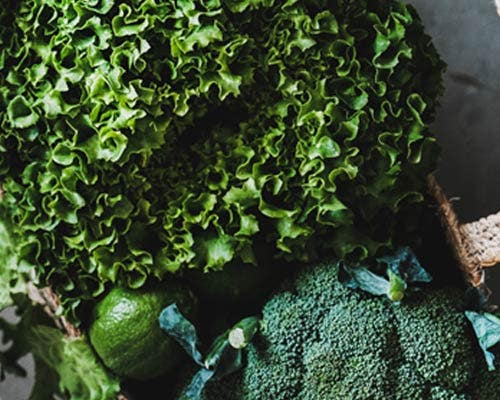5 Sources of Calcium for Vegans & Non-Dairy Diets
- 4/4/17

For many people who follow a vegan or dairy-free diet, it may initially be difficult to seek out alternative sources of calcium. Whatever the reason for choosing a plant-based diet, whether to help reduce inflammation from milk products or for ethical purposes to avoid eating animal products, there are many ways to still eat a balanced diet with necessary calcium intake. As calcium is responsible for not only bone health but also nerve and muscle function as well as blood clotting, having a variety of foods to choose from will help avoid monotony and ensure good nutrition. According to the Mayo Clinic, adults 19-50 years old should get 1,000 mg of calcium daily. Adults 51 and older should take 1200 mg.
According to The Vegetarian Resource Group, a 1 cup serving of collard greens provides about 400 mg of calcium. Kale is another one the highest sources, with about 200 mg per serving. Mustard greens, turnip greens, watercress, and broccoli are also good sources, according to WebMD. When choosing leafy greens, be sure to avoid those that contain high levels of oxalates, which are compounds that can inhibit calcium absorption. Beet greens, Swiss chard, rhubarb, and spinach are abundant in calcium but are high in oxalates, so should be limited or eaten alone as to not diminish the benefits of calcium-rich sources not full of oxalates.
A cup of raw white beans contains nearly 200 mg of calcium, and are a tasty addition to pasta dishes. They can also be substituted for chickpeas in hummus. Black-eyed peas also contain about 200 mg per serving, and are great with collard greens in soup. Almonds are a portable snack rich in calcium, and are great salad toppers when sliced. Hemp seeds, also known as hemp hearts, are another rich source of calcium as well as protein. They are also good for salads and are a satiating addition to vegetable-based smoothies.
When available, choose calcium-fortified foods and beverages, as suggested by the Mayo Clinic. Many soy products like tofu, cereals, milk substitutes like rice milk, vegan protein bars, rice, and fruit juices such as orange juice are now available in calcium-fortified versions.
To fully absorb calcium and obtain its benefits, the body requires vitamin D, according to the Mayo Clinic. Nearly three-quarters of U.S. adults and teens are vitamin D deficient, as reported by Scientific American and several studies, including research published in the Archives of Internal Medicine. Insufficient calcium from diet and lack of sunlight are the main causes. Symptoms of vitamin D deficiency include muscle pain, low energy and fatigue, lowered immunity, depression, weight gain, and sleep irregularities. Experts recommend at least 1,000 IU of vitamin D every day for most people. Just 10 minutes of direct midday sunlight can produce about 10,000 IU of the vitamin, says U.S. News Health. For non-vegans, fatty or oily fish, such as salmon, tuna and sardines, are good sources of vitamin D, as well as egg yolks.
For many people with active lifestyles, eating well on-the-go or especially while traveling can be difficult. To help maintain balanced nutrition, a plant-based calcium supplement is a great way to ensure adequate calcium intake. Be sure to choose one that has vitamin D added (for better absorption) and one that is free from crushed limestone, rock and chalk—plant-based only.
- Eat more dark leafy greens.
According to The Vegetarian Resource Group, a 1 cup serving of collard greens provides about 400 mg of calcium. Kale is another one the highest sources, with about 200 mg per serving. Mustard greens, turnip greens, watercress, and broccoli are also good sources, according to WebMD. When choosing leafy greens, be sure to avoid those that contain high levels of oxalates, which are compounds that can inhibit calcium absorption. Beet greens, Swiss chard, rhubarb, and spinach are abundant in calcium but are high in oxalates, so should be limited or eaten alone as to not diminish the benefits of calcium-rich sources not full of oxalates.
- Eat some beans, nuts, and seeds.
A cup of raw white beans contains nearly 200 mg of calcium, and are a tasty addition to pasta dishes. They can also be substituted for chickpeas in hummus. Black-eyed peas also contain about 200 mg per serving, and are great with collard greens in soup. Almonds are a portable snack rich in calcium, and are great salad toppers when sliced. Hemp seeds, also known as hemp hearts, are another rich source of calcium as well as protein. They are also good for salads and are a satiating addition to vegetable-based smoothies.
- Choose calcium-fortified foods.
When available, choose calcium-fortified foods and beverages, as suggested by the Mayo Clinic. Many soy products like tofu, cereals, milk substitutes like rice milk, vegan protein bars, rice, and fruit juices such as orange juice are now available in calcium-fortified versions.
- Get some sun and vitamin D.
To fully absorb calcium and obtain its benefits, the body requires vitamin D, according to the Mayo Clinic. Nearly three-quarters of U.S. adults and teens are vitamin D deficient, as reported by Scientific American and several studies, including research published in the Archives of Internal Medicine. Insufficient calcium from diet and lack of sunlight are the main causes. Symptoms of vitamin D deficiency include muscle pain, low energy and fatigue, lowered immunity, depression, weight gain, and sleep irregularities. Experts recommend at least 1,000 IU of vitamin D every day for most people. Just 10 minutes of direct midday sunlight can produce about 10,000 IU of the vitamin, says U.S. News Health. For non-vegans, fatty or oily fish, such as salmon, tuna and sardines, are good sources of vitamin D, as well as egg yolks.
- Take a calcium supplement.
For many people with active lifestyles, eating well on-the-go or especially while traveling can be difficult. To help maintain balanced nutrition, a plant-based calcium supplement is a great way to ensure adequate calcium intake. Be sure to choose one that has vitamin D added (for better absorption) and one that is free from crushed limestone, rock and chalk—plant-based only.





